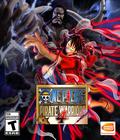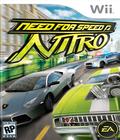Electronic Arts has been getting pretty desperate lately with the Need for Speed series. After two generally disliked entries with ProStreet and Undercover, it's difficult to blame them for wanting to reformulate the series. One of the more brilliant decisions made in the process of attempting to revitalize the series was to declare "distinct game on Wii." While Need for Speed: Shift went for a more realistic, "driver in the cockpit" style of racing, Need for Speed: Nitro turns back the clock and uses pieces from a completely different clock to brilliant effect. With just a few interface changes, they could easily have slapped the Burnout sticker on this game. Instead, the result is a sweet hybrid of some of the most enjoyable times from Need For Speed's long history, mixed with the right amount of classic Burnout elements to create something just new enough to prove that EA still knows how to create something fresh, fun and, with recent price cuts, superior to most anything you could get in the $30 range for the Wii.
Like ProStreet and most Burnout games, Nitro is preciously short on plot. A Burnout-like cut scene explains the basics, including how to use the new Wiimote-based control scheme, such as how winning enough races might get you money to get out of here. "Here" is initially Rio de Janeiro, one of five cities around the world in which you can race. There isn't much plot other than a quick establishment of a cartoonish archetype character for each area and the setup of the courses. Surprisingly, the other characters avoid feeling like stereotypes but still manage to pull off relevant bits of humor. For example, Omar, the second-best racer, modifies his tricked-out car into a giant fan to cool off his little street corner — a simple, but effective, visual gag that avoids visual stereotyping.
Outside of the gameplay, the menus are kept simple. Log in to one of the profile slots (they're not portable so you can't take your save game to a friend's house), hit the garage menu if you want to change your car's appearance (no stat upgrades), select a challenge, pick one of the cars in your garage, and play. It's pretty simple, with plenty of nice elements, including not requiring the Wiimote to point at the screen for anything, although it's certainly nice for customizing vehicle details.
In-game controls, similarly, remain simple and accessible, with the game allowing you to play with the Wii Remote in a one- or two-handed style, the Nunchuk, the Classic Controller, or the GameCube controller. Yes, I just said one-handed. People who drive a car adapted for one-handed driving may find this familiar, as you simply hold the Wii Remote like a joystick, using the thumb to accelerate, the index finger to brake, and shaking it forward to trigger your Nitrous. The results of the modes are simple and, more importantly, get the job done. The game offers a Steering Assist to make things easier, though I didn't find it to be very helpful, especially in many of the tougher races.
The race course set is a bare-bones, old-school Burnout-like layout, consisting of all the classic race forms, including old-fashioned drag races, which take short, straight snippets of courses, lock you into manual transmission, and put you into a straight-out acceleration contest. All racers now have a split Nitrous tank; after fully charging one tank, you can charge a second tank, albeit more slowly. You can fire a single tank at any time, and then, by shaking or pushing the button again, fire both tanks at once for a ridiculous speed boost that can turn a race around. Charging the tanks is limited to sensible mechanics (drifting, drafting, using Nitro for the entire tank duration, and being in the lead). One major twist comes in the behavior of the police; quite different from my introduction to the series with Carbon, police are a constant hazard to mess up any race. Causing damage, hitting cops or being in the lead of the race will attract more heat, and this means that more Hummers will come after you in an attempt to take you out of the running.
The game has a Mario Kart element in the form of two usable items. The most important of these repairs your car and your Nitrous tanks, but you can also redirect heat from the police toward another racer to try and screw him up. The effects of this usually aren't very nasty; it isn't especially difficult to get away from the cops since there is no post-race getaway, and blockades only show up during specific challenges.
This core gameplay structure is pure typical arcade racer, overall, but it captures the best parts of arcade racing, especially with the help of its graphics. The Wii can't really push all that many polygons but works around this by a list that doesn't have many intensely detailed cars. The game oozes a high-energy, fun style, mostly represented by having cars like the Volkswagen Type 2 (a van) racing alongside the Toyota Sprinter Trueno GT-APEX (AE86), famous in rally racing and known among anime nerds as the main character's car in "Initial D." As you race, the leader paints the track with his insignia, graffiti pattern and primary color, providing a nicely visual reward for being ahead of the pack. EA has figured out how to do more with less with the graphics in Nitro, and it works beautifully.
Unfortunately, the game's soundscape didn't click for me as much. Maybe I'm just too spoiled by Forza Motorsport 3, but neither the engine noises nor the soundtrack selections really seemed to "click" for me, with the exception of the end-of-race section, which provides a nice, swooshy outro noise and then goes to a special clip of the race song. It's a sad weakness, but not precisely a gamebreaker.
The bigger weaknesses would be its rather lacking depth. There's no customization, and anyone who has ever Snaked in Mario Kart DS will be right at home here, triggering double-Nitros in rapid enough succession that the tiny speed loss with each drift will be irrelevant. After all, the game provides a multiplier for multiple drifts in a row and then makes it very easy to stay straight while making quick drifts that only sap about 2 MPH from your speed, and it's easy to accelerate right back while you maintain the combo.
Overall, Need for Speed: Nitro does what it was set out to do and does it right. It doesn't feel like Shift, instead playing like something made for the Wii audience. It's got its flaws, but it also has a fast, easy-to-pick-up gameplay and just enough depth to be worth a purchase for a wide swath of Wii gamers. Due to lagging sales, EA and various retailers have been regularly offering great prices on this title. If you see it for $30, be certain to grab it. The odds are quite good that you won't regret it.
Score: 7.8/10
More articles about Need for Speed Nitro










 Boasting a wholly unique look and feel, Need for Speed Nitro delivers the fun and exhilaration of high-speed racing, as you battle through the mayhem of aggressive cops, take corners at 150 mph, and own the competition on extreme tracks.
Boasting a wholly unique look and feel, Need for Speed Nitro delivers the fun and exhilaration of high-speed racing, as you battle through the mayhem of aggressive cops, take corners at 150 mph, and own the competition on extreme tracks.



























